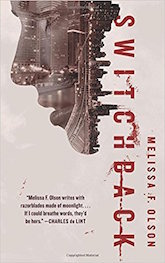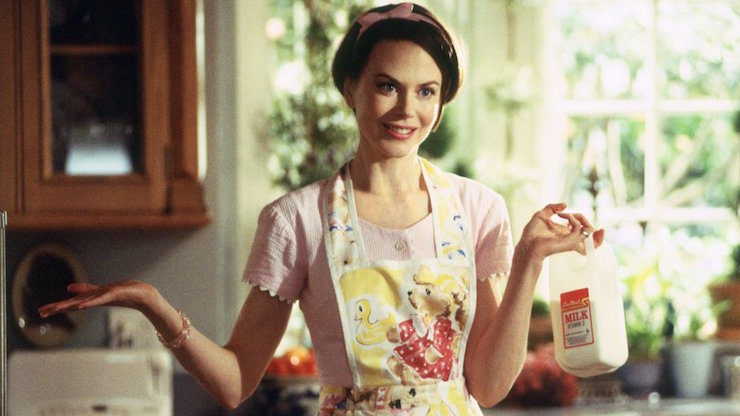I was recently asked, by a book review website doing a horror showcase, what advice I would give new horror writers. My response was, “Write about a place that scares you.”
In retrospect I worry that it’s a bit trite and obvious, but that doesn’t make it less true, at least for me. A barn owned by a professional welder, filled to hoarder levels with shards of rusty metal; a cornfield at midnight during late summer, when the corn stalks go well above your head; a public garden that used to be a cemetery, only they didn’t move all the bodies—these are all real places that inspired scenes in my books. And for my most recent book, the Tor.com novella Switchback, I wrote about…
Suburbs.
I know—it’s not exactly up there with the rusty metal shards thing, is it? But the aesthetically perfect, upper-middle-class suburbs made famous by John Hughes movies have always unsettled me, just a little. And I’m not alone: The idea that suburbs can be terrifying has been around since the seventies. But until recently, it never occurred to me to ask why.
Why do suburbs scare us?
After all, the whole concept of pretty, cookie-cutter neighborhoods started innocently enough. Returning World War II soldiers and their families were sold on the “perfection” of the suburbs: the independence of owning your own home, the satisfaction of beautiful lawns and appliances, the safety and community. After two world wars and a Great Depression sandwiched between, I’d imagine the idea of clean, shining perfection was pretty appealing.
Twenty-five years later, though, the first generation of suburban kids had grown up, developing a deep unease and distrust of this attempted perfection. As a result, we got books and films like The Stepford Wives, Carrie, Poltergeist, Halloween, “The Lottery,” and so on. The problem with the suburbs, these works argued, is that their quest for perfection becomes a quest for conformity—and conformity breeds corruption, in all its forms.
Rebellious, feminist Joanna Eberhardt must be replaced in order to keep Stepford pure and perfect. Carrie’s classmates torment her because they cannot tolerate her awkwardness, her deviation from the norm. Television culture literally consumes little Carol Ann Freeling, and Michael Myers is the product of a dark psychosis lurking beneath the sheen of suburban utopia. In fact, it seemed that there was always a dark psychosis lurking beneath the suburbs, whether supernatural or man-made.
Looking at it in context, I can see why those artists used horror to rebel against suburban perfection—and why, at the time, these ideas were as subversive as they were unsettling.
But we are now forty-five years post-Stepford, and the way we view suburbia has changed. Just as the filmmakers and writers of the seventies were the first generation of suburban kids, mine is the first generation to become adults in a post-9/11 world. Our forbearers used film and literature to stress independence, rebellion, and critical thinking because they had conformity shoved down their throats—but we weren’t taught conformity. Instead, we were taught to prioritize safety above anything else.
Over the last sixteen years, we have been told, again and again, that the world is dangerous, that terrorism is dangerous, that too much freedom is dangerous. The economy is unstable. The government is unstable. Even our ideas, about politics, religion, and equality, are constantly in flux as they are challenged and tested on social media. The ground beneath us is shifting often and drastically, so we have retreated to the one place we still feel safe: home. And if there’s one thing that everyone knows about the suburbs, it’s that they’re a safe place to call home. Right?
The tide has turned back toward a cultural appreciation for the suburbs—now our horror is about these neighborhoods being invaded by outside (or Upside Down) forces. Yes, if the wild success of Stranger Things and It has taught us anything, it’s that nostalgia for eighties suburbia is a powerful force. And I don’t trust it. Art’s power to create intense sentimentality can reach levels of irresponsibility, for one thing (remember that time Ryan Gosling saved jazz?), but more importantly, it’s crucial to keep in mind that the suburbs of today are very different from those in the 1970s and 1980s.
Today’s suburbia is a place of Homeowners Associations, control, rules: the length of your lawn and the number of cars parked in the driveway, the amount of Christmas lights, height of your fences. Even the terminology has shifted: suburbs are now “planned communities,” meaning there’s little chance for individualism before you even move in. (Speaking of terminology, it’s worth mentioning that in many areas, the suburbs have become synonymous with whiteness.) The difference become conformity and uniformity is small, but important. If conformity breeds corruption, what can come of uniformity?
Buy the Book


Switchback: A Nightshades Novel
Which brings me back to Switchback. A couple of years ago I wrote a novella about an FBI task force created to address the threat of vampire-like creatures in Chicago. Nightshades is about the team’s first case together, and ends with them sort of finding their footing as a team. In the second book I wanted to knock them all off-balance again, and I figured the most fun way for me to do that would be to send them to the suburbs—excuse me, to a planned community.
Only this isn’t terrifyingly perfect neighborhood of Stepford, or the creepy sewers of Derry. This is Switch Creek, Illinois, a rich, mostly white suburb where toxic masculinity and forced fraternity reign over families who want nothing more than to hide away from the world in their own artisan-crafted paradise. Of course I had to throw murderous vampires at them. Of course I did. Because while I don’t have many concerns about vampires, Switch Creek—and its real life counterparts—really scares me.
I hope it scares you, too.
Melissa Olson is the author of six Old World novels for 47North as well as the Nightshades and its sequel, Switchback—available now from Tor.com Publishing. She lives in Madison, WI with her husband, two kids, three dogs, and a jittery chinchilla.










